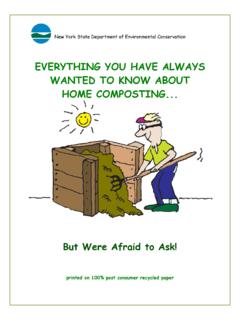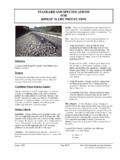Transcription of New York State’s Approach to the Remediation of Former ...
1 New York State's Approach to the Remediation of Former Manufactured Gas Plant Sites Bay Shore, NY MGP. Division of Environmental Remediation Department of Environmental Conservation Table of Contents Part 1: History and Overview of Manufactured Gas Plant Sites .. 1. Overview of Department Approach to Former MGP Site Remediation .. 1. Historic Development of MGPs .. 1. The Gas Manufacturing Process .. 2. Potential Environmental and Public Health Impacts of MGP Sites .. 3. Making Gas versus Storing Gas .. 4. Other Gas Technologies .. 5. MGP Sites Today .. 6. MGP Sites Currently Identified in New York State .. 6. Table 1: MGP Sites by Responsible Utility .. 7. Figure 1: Distribution of MGP Sites in NYS .. 7. Part 2: Technical Considerations in MGP Site Remediation .. 8. Special Technical Considerations at MGP Sites .. 8. MGP Sources of Contamination .. 8. Non- aqueous phase liquid (NAPL) mobility .. 8. Interim Remedial Measures (IRMs) .. 9. Community Health and Safety .. 9. Odor Control.
2 9. Remedial Approach for MGP Sites .. 10. Source Area Removal .. 10. Surface Soil Remediation .. 10. Subsurface Soil Remediation .. 11. Non-Aqueous Phase Liquid Collection and Disposal .. 11. Groundwater Remediation .. 11. Sediment Remediation .. 11. Remedial Decision-making at MGP Sites .. 12. Remedy Selection .. 12. Citizen Participation (CP) in the MGP Program .. 12. Cleanup Levels .. 12. New Technology Use .. 12. Institutional Controls .. 13. Use of Institutional Controls .. 13. Environmental Easements .. 13. Prioritization of Site Remedial Activities at MGP Sites .. 13. Site Characterization .. 13. Remedial Investigation/Feasibility Study .. 14. Remedial Design .. 14. Enforceable Schedule for Remediation at MGP Sites .. 15. Appendix A: Some Commonly Used MGP Terms .. 16. Part 1: History and Overview of Manufactured Gas Plant Sites Overview of Department Approach to Former MGP Site Remediation To address the Manufactured Gas Plant (MGP) legacy in New York State, the Department of Environmental Conservation's Division of Environmental Remediation has established one of the most aggressive MGP site investigation and Remediation programs in the country.
3 The evolution of the Department program as well as a history and overview of MGPs is provided in Part 1. Part 2 will detail the Department's Approach to the more technical aspects of the Remediation of MGP sites. While the existence of Former MGPs was known, the potential numbers of these plants became apparent in the early 1990s. Initially, the New York State Department of Environmental Conservation (Department) viewed the remedial program for Former MGP sites as consisting of limited removal actions or interim remedial measures, similar to the removal of underground petroleum storage tanks. With the passage of time the Department's understanding of the complexity of these sites grew, as investigations identified the extent of the contamination problems associated with many MGPs. Accordingly, the Department program was restructured. In 2000, additional staff were dedicated to the MGP remedial program and the focus shifted from the limited removal based Approach to the more traditional Superfund site remedial Approach , for nearly all MGP sites.
4 The process starts with a site characterization, progresses to a remedial investigation, then to a feasibility study and continues into the design and construction of the remedy. This Approach has proven successful. Projects continue to move forward through the remedial process, while the total number of sites under order or agreement has increased steadily from approximately 90 to more than 200 today. The dedicated MGP group reflects a recognition of the need for a consistent Approach between the eight utilities and MGP sites in general. This need is highlighted by the reality that most utilities have sites in two or more of the Department's regions. This group, in addition to fostering a consistent Approach and decision-making, has developed a high level of expertise in the investigation and Remediation of these sites. Staff are frequently consulted by other states and participate in conferences and work groups at national and international levels. Historic Development of MGPs MGPs have a long history in New York State, starting in 1826 with a small demonstration plant in New York City that produced gas from whale oil.
5 From this modest beginning through the closure of the last active plant in1972, MGPs were a visible and important part of life throughout the State. The original focus for the industry was to supply small amounts of gas for street lighting systems. This changed quickly with rapid growth experienced in the mid-1800s such that, by the gaslight era of the l880s and 1890s, gas was being widely used for lighting, heating and cooking. New plants were built and old ones expanded to meet the sharply growing demand. The plants required large amounts of water to operate. Accordingly, most of them were located along the shoreline of a water body. Networks of pipes and storage facilities made gas available throughout a town or city. Most towns in New York State with populations of more than 5,000 had at least one gas plant. To date, more than 200 MGP sites have been found statewide, and it is estimated that up to 300 may exist. Smaller MGPs also operated during this time period, providing gas for individual factories or institutions.
6 A trend toward regional consolidation took hold in the 1930s, in which small town MGPs Remediation of Former MGP Sites Page 1 of 17. often closed and were replaced by short-distance pipelines to neighboring plants a few miles away. As World War II approached, longer interstate pipelines were built, making cheaper natural gas from the Midwest more widely available. Most New York MGPs had closed by the1950s, but a few remained in operation on standby status in areas where the pipelines could not meet peak demand. The last MGP. in New York State ceased operations in 1972. 1874 Gas Holder in Troy, NY. The responsibility for most of the MGPs identified in the State can be tied to one of the nine gas utilities which still operate in the state. These companies either owned/operated the plants themselves or became successor companies to the original owners/operators through mergers or consolidations. It should be noted that some gas manufacturing companies (particularly in smaller towns) went out of business without being consolidated or taken over by larger utility companies.
7 The New York State Department of Environmental Conservation continues its research efforts to locate these plants so they can be investigated and, if necessary, cleaned up. A table showing the distribution of MGP sites among the utilities and a figure showing their general locations across the State is included on page 7. Information relative to individual sites can be found on the Department website at: The Gas Manufacturing Process Two main processes were used to manufacture gas. The older and simpler process was coal carbonization in which coal was heated in closed retorts or beehive ovens. Volatile constituents of the coal would be driven off as a gas, which was collected, cooled and purified prior to being piped into the surrounding areas for use. As the MGP industry developed and expanded after the Civil War, a new process was introduced which produced a gas mixture that burned hotter and brighter. This process, known as carburetted water gas (CWG), was first introduced in the 1870s.
8 By 1900, most MGPs in New York State were using it. A. variety of water gas processes were developed, all of which started by heating coke or coal in the presence of steam. This first step produced a flammable gas mixture of methane and carbon monoxide. Remediation of Former MGP Sites Page 2 of 17. Petroleum products were then sprayed into the hot gas mixture creating more methane, which increased the heating and lighting value of the gas. Potential Environmental and Public Health Impacts of MGP Sites The production of manufactured gas created waste products which are resistant to natural decay and often result in potential effects on public health and the environment. Some of these wastes still remain at Former MGP sites. The primary waste was a dense, oily liquid known as coal tar which condensed out of the gas at various stages during its production, purification and distribution. Although some of the tar was collected for sale or reuse, recovery was incomplete. In the decades during which many of these MGPs operated, substantial amounts of tar leaked from storage and processing facilities or was discharged into nearby water bodies.
9 Soils, groundwater and sediments which came into contact with the tar became heavily contaminated, and in many cases remain contaminated today. MGP on the bank of the Hudson River in Nyack, NY. The tar produced from the coal carbonization process was a fairly viscous material which had a wide variety of economic uses. Significant efforts were made to recover this tar for sale. Dyes, explosives and a wide variety of other chemical products were developed using true coal tar as a starting material. Tars from the water gas process were far less valuable and were much more difficult to recover and process. Separating the tar from the water emulsion in which it was produced was slow and difficult. Most of the coal tar we encounter at MGPs today is actually water gas tar, which was actually derived from liquid petroleum products, not coal. Water gas tar is less viscous than true coal tar and is therefore more likely to move as a liquid through subsurface soils. Tars from both processes contain a family of chemicals known as polycyclic aromatic hydrocarbons or PAHs.
10 These compounds do not readily dissolve in water, so they are rarely found to have migrated farther than the tar itself. The tars also contain a family of volatile organic compounds known as BTEX. (an abbreviation for the individual compounds benzene, toluene, ethylbenzene and xylene). These compounds are more soluble than the PAHs and are often found as groundwater contaminants around MGP sites. Tars often contain enough benzene to meet the legal definition of a hazardous waste. The gas purification process also produced a solid waste material. Known as purifier waste or box Remediation of Former MGP Sites Page 3 of 17. waste, it is typically a mixture of wood chips, iron filings and clumps of solidified tar. As a solid, it does not migrate through the subsurface the way liquid tar does. However, it can be a source of groundwater contamination and has a strong and offensive odor when exposed at the ground surface. Blue-colored purifier waste chips at the National Grid Harbor Point site in Utica, NY.
















